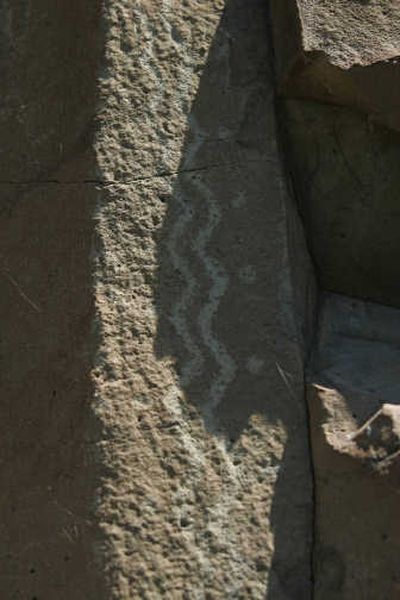Wanapum history is carved in stone

WANAPUM DAM, Wash. – Wanapum leader Rex Buck Jr. studies the basalt cliffs above the Columbia River where his ancestors tucked their stories in shadows and caves.
It’s a hot afternoon in early August. Buck’s two salt-and-pepper braids rustle from the wind in the back of a 22-foot brown river patrol boat traveling downriver near Wanapum Dam.
The cliffs don’t give away any secrets, and neither will the Wanapum River Patrol. While Buck is not a regular patrolman, he is one of the few who know specifically what they protect.
Every artifact, petroglyph and spiritual landmark along the river has a story, some more than 11,000 years old, according to archaeological studies.
The Grant County PUD and the Wanapum formed the fleet in 2000 with a pact to make sure the ancient and sacred safely co-exist with the river’s modern users.
“This is where the Wanapum were put,” Buck said. “We were put here for a reason, to take care of this land. Not because it’s something that maybe you say you own … but because it belongs to the next generation.”
About 15 patrolmen watch for looters, illegal development and changes in wildlife migration. They also act as river lifeguards, handing out river safety advice and trash bags.
The patrol travels the 58-mile stretch between Priest Point and Rocky Reach Dam, 365 days a year. When or where the patrols will be on watch is purposefully unpredictable.
The Wanapum have preserved more than 50,000 artifacts in a repository, said Angela Buck, cultural resource specialist at the Wanapum Heritage Center. Not everything could be moved behind museum glass.
Ancient symbols – sunbursts, animals and circles, for example – remain tucked between basalt cliffs. Special rock formations, caves and other sites are unmovable, yet still regarded as sacred.
“Those things were put there for a reason; it’s not for you or me or anyone to decide,” Angela Buck said. “We don’t know enough to use it, but we know enough not to bother it.”
Former Wanapum leader Johnny Buck, Rex Buck’s grandfather, told stories of mythical creatures called “the mud people” who carved hundreds of symbolic shapes into the rocks on Whale Island.
The place was sacred to the Wanapum. Women and children were not allowed to walk along its shores.
Archeologists and PUD staff made rubbings and took photos of the carvings before the Wanapum Dam was finished. The island was submerged by 1963.
Knowledge that remains is inherited, passed down through Wanapum story telling, Rex Buck said.
“If I was told a story, I could tell you the detail of what was here, whether it was a burial site, whether it was a sacred site, whether it was a food gathering area, whatever it was,” Buck said. “I might have never been here but in my mind it’s imprinted that I was here. That’s how detailed the story was.”
The Wanapum was an oral culture society, which means they relied on stories to transmit history and culture through the generations, similar to Homeric epic poetry.
Oral culture is also a different kind of literacy. Instead of using writing or print, the Wanapum record the information with photographic memory and storytelling techniques such as speaking in threes and run-on sentences, Buck said.
The last oral-culture generation is growing older, Buck said. Buck, 52, is one of the last among the Wanapum.
“The younger generation didn’t grow up in the same type of environment that we grew up in, my generation and the generation before me,” Buck said.
He said the new Wanapum have shorter attention spans. They text-message friends during the elders’ stories and carry around iPods, Buck said.
“It (the boat patrol) provides them the opportunity to be on the river, to walk the land, to see the animals, to see the birds, to see the water,” Buck said.
“As they begin to get into the river they come out here and see things,” Buck said. “They come back and want to know. They want to know who they are and where they came from. They seek the knowledge of the elders.”
The youth also have a lot to offer in their understanding of technology, Buck said.
The study of elk migrations and other wildlife along the river is part of the river patrol’s duties. Everything is logged with GPS and computer-tracking data.
“You got an archaeologist, and he’s got terms,” Buck said. “You have a collections manager and she has terms. You have an engineer and he’s got terms. They don’t understand if we speak to them, but if they speak to one another they clearly understand. We’ve got to have that credibility.”
The patrol is also a way for the Wanapum to maintain an active presence on the river, despite the modern development moving in, Buck said.
“We can co-exist with the people that use it, but we should also be sensitive and make them aware,” Buck said. “There’s laws that protect the resources and requirements under the (dam) license that provide for those things to be protected and preserved.”